Optimizing the Layout of a Ground Source Heat Pump System with a Groundwater–Thermal Coupling Model
Abstract
:1. Introduction
2. Materials and Methods
2.1. Study Area
2.2. Sample Collection
2.3. Method
3. Results and Discussion
3.1. Response Characteristics of the Groundwater–Thermal System under Actual Operation
3.1.1. Intra-Annual Variation Characteristics of the Geotemperature under Intermittent Operation
3.1.2. Multi-Year Variation Characteristics of the Geotemperature under Intermittent Operation
3.2. Layout Optimization of the GSHP System
3.2.1. Changing the Operating Parameters of the BHEs
Illustrates Indicate
3.2.2. Changing the Layouts and Settings of the BHEs
3.2.3. Artificial Intervention in the Groundwater Flow Field
4. Conclusions
- During the actual operation of the GSHP system, the intra-annual variation in geotemperature demonstrated the cold and heat accumulation cycle. Cold accumulates in the heat exchange area and the surrounding rock-soil body after a prolonged period of operation, and a particular range of cold plumes is formed downstream due to groundwater runoff;
- The heat exchange power is changed so that the amount of heat exchange is the same in the winter and summer; the problem of cold and heat accumulation can be alleviated to some extent. A program that simultaneously changes the heat exchange power and the length of the heat exchange period so that the amount of heat exchange is the same is more effective for suppressing cold and heat accumulation compared to other programs;
- In different buried pipe operation methods, the upstream cooling and downstream heating methods do not effectively alleviate the accumulation of heat and cold in the heat exchange area but rather create a more serious accumulation problem around the heat exchange area. However, the cross-layout of cooling and heating holes is a better solution because it can effectively relieve the accumulation of heat and cold in the heat exchange area and simultaneously inhibit the transportation of cold and thermal plumes to the surrounding area;
- A combination of pumping and recharge wells around the heat exchange area is less likely to produce cold and heat accumulation. The combination of multiple pumping and recharge wells located downstream is the preferred option, which causes less disturbance to the geotemperature field in the upstream region than the upstream recharge option.
- In this study, the optimization scheme of a GSHP system was qualitatively discussed using numerical simulation. Therefore, future research can carry out quantitative calculations for the scenarios with better results to explore the optimal solution for the operation of the GSHP system.
Author Contributions
Funding
Data Availability Statement
Acknowledgments
Conflicts of Interest
Nomenclature
| 3D | Three-dimensional |
| BHE | Borehole heat exchanger |
| GSHP | Ground source heat pump |
| GTF | Geotemperature fluctuations |
References
- Zhou, Z.Y.; Liu, S.L.; Liu, J.X. Study on the Characteristics and Development Strategies of Geothermal Resources in China. J. Nat. Resour. 2015, 30, 1210–1221. [Google Scholar] [CrossRef]
- Liu, A.; Zheng, J.; Li, J.; Du, J.; Li, F. Comparison Study on Resource Evaluation Methods of Shallow Geothermal Energy and Traditional Geothermal Energy. Urban Geol. 2018, 13, 37–41. [Google Scholar] [CrossRef]
- Xu, Y.S.; Wang, X.W.; Shen, S.L.; Zhou, A. Distribution Characteristics and Utilization of Shallow Geothermal Energy in China. Energy Build. 2020, 229, 110479. [Google Scholar] [CrossRef]
- Zhang, L.; Chen, S.; Zhang, C. Geothermal Power Generation in China: Status and Prospects. Energy Sci. Eng. 2019, 7, 1428–1450. [Google Scholar] [CrossRef]
- Wang, G.; Lu, C. Progress of Geothermal Resources Exploitation and Utilization Technology Driven by Carbon Neutralization Target. Geol. Resour. 2022, 31, 412–425+341. [Google Scholar] [CrossRef]
- Wang, S.; Li, F.; Yan, J.; Hu, J.; Wang, K.; Ren, H. Evaluation Methods and Application of Geothermal Resources in Oilfields. Acta Pet. Sin. 2020, 41, 553–564. [Google Scholar] [CrossRef]
- Li, Z.; Sun, J. Investigation and Analysis of New Energy Technology Application Status in Beijing—Water Source Heat Pump System. In Energy Solutions to Combat Global Warming. Lecture Notes in Energy; Zhang, X., Dincer, I., Eds.; Springer: Cham, Switzerland, 2017; Volume 33, pp. 497–507. [Google Scholar] [CrossRef]
- Shah, A.; Krarti, M.; Huang, J. Energy Performance Evaluation of Shallow Ground Source Heat Pumps for Residential Buildings. Energies 2022, 15, 1025. [Google Scholar] [CrossRef]
- Wang, S.; Gao, J.; Zhang, X.; Wang, Y.; Cai, X. Experimental and Numerical Investigations on the Thermal Behavior of Ground Heat Exchanger in Stratified Soils across Unsaturated and Saturated Layers. Appl. Therm. Eng. 2021, 195, 117163. [Google Scholar] [CrossRef]
- Wei, W.; Zheng, G.; Luan, Y. Characteristics and influencing factors of the shallow geothermal field in Beijing plain area. Geol. China 2010, 37, 1733–1739. [Google Scholar]
- Yang, W.; Kong, L.; Chen, Y. Numerical Evaluation on the Effects of Soil Freezing on Underground Temperature Variations of Soil around Ground Heat Exchangers. Appl. Therm. Eng. 2015, 75, 259–269. [Google Scholar] [CrossRef]
- Zhou, Y.; Mu, G.; Zhang, H.; Wang, K.; Liu, J.; Zhang, Y. Geothermal field division and its geological influencing factors in Guanzhong basin. Geol. China 2017, 44, 1017–1026. [Google Scholar] [CrossRef]
- Wang, W.; Wang, G.; Liu, F.; Liu, C. Characterization of Ground Thermal Conditions for Shallow Geothermal Exploitation in the Central North China Plain (NCP) Area. Energies 2022, 15, 7375. [Google Scholar] [CrossRef]
- Sauty, J.P.; Gringarten, A.C.; Fabris, H.; Thiery, D.; Menjoz, A.; Landel, P.A. Landel Sensible Energy Storage in Aquifers: 2. Field Experiments and Comparison with Theoretical Results. Water Resour. Res. 1982, 18, 253–265. [Google Scholar] [CrossRef]
- Russo, S.L.; Taddia, G.; Verda, V. Development of the Thermally Affected Zone (TAZ) around a Groundwater Heat Pump (GWHP) System: A Sensitivity Analysis. Geothermics 2012, 43, 66–74. [Google Scholar] [CrossRef]
- Li, C.; Cleall, P.J.; Mao, J.; Muñoz-Criollo, J.J. Numerical Simulation of Ground Source Heat Pump Systems Considering Unsaturated Soil Properties and Groundwater Flow. Appl. Therm. Eng. 2018, 139, 307–316. [Google Scholar] [CrossRef]
- Luo, Z.; Du, J. Heat exchange scheme simulation optimization for ground source heat pump system with buried pipes by thermal equilibrium analysis. Trans. Chin. Soc. Agric. Eng. (Trans. CSAE) 2018, 34, 246–254. [Google Scholar] [CrossRef]
- Long, X.T.; Yuan, R.Q.; Pi, J.G.; Sun, X.L.; Liu, C.M. Survey and Evaluation of Shallow Geothermal Energy in Changsha. J. Nat. Resour. 2016, 31, 163–176. [Google Scholar] [CrossRef]
- Wu, X.; Liu, W.; Lu, Z.; Liang, P.; Jin, G. Simulation on temperature variation characteristics of soil around buried pipe in process of heat storage and release. Trans. Chin. Soc. Agric. Eng. (Trans. CSAE) 2017, 33, 204–213. [Google Scholar] [CrossRef]
- Han, C.; Yu, X. Sensitivity Analysis of a Vertical Geothermal Heat Pump System. Appl. Energy 2016, 170, 148–160. [Google Scholar] [CrossRef]
- Hałaj, E.; Pająk, L.; Papiernik, B. Finite Element Modeling of Geothermal Source of Heat Pump in Long-Term Operation. Energies 2020, 13, 1341. [Google Scholar] [CrossRef]
- You, T.; Wu, W.; Shi, W.; Wang, B.; Li, X. An Overview of the Problems and Solutions of Soil Thermal Imbalance of Ground-Coupled Heat Pumps in Cold Regions. Appl. Energy 2016, 177, 515–536. [Google Scholar] [CrossRef]
- Long, T.; Chen, G.; Hu, C.; Wang, B. Research on Hydro-thermal Coupling of the Borehole Heat Exchangers. Saf. Environ. Eng. 2015, 22, 16–21+27. [Google Scholar] [CrossRef]
- Li, H.; Nagano, K.; Lai, Y.; Shibata, K.; Fujii, H. Evaluating the Performance of a Large Borehole Ground Source Heat Pump for Greenhouses in Northern Japan. Energy 2013, 63, 387–399. [Google Scholar] [CrossRef]
- Kaneko, S.; Tomigashi, A.; Ishihara, T.; Shrestha, G.; Yoshioka, M.; Uchida, Y. Proposal for a Method Predicting Suitable Areas for Installation of Ground-Source Heat Pump Systems Based on Response Surface Methodology. Energies 2020, 13, 1872. [Google Scholar] [CrossRef]
- Shang, S.; Liu, J.; Liu, B.; Ji, M.; Li, L. Ground-Coupled Group Heat Exchanger Factors Affecting Temperature Simulation. J. Shenyang Jianzhu Univ. 2018, 34, 566–576. [Google Scholar] [CrossRef]
- Ning, H.; Hu, C.; Chen, G.; Long, T. Analysis and Simulation of Heat Transfer Performance of Buried Pipe Banks Under Artificial Flow Field: Taking an Area in Fujian Province as an Example. Geol. Sci. Technol. Inf. 2018, 37, 239–245. [Google Scholar] [CrossRef]
- Tsuya, S.; Fujii, H.; Kosukegawa, H.; Yamashita, K.; Bina, S.M. Effect of Pumping Well Operation on Borehole Heat Exchangers. Geothermics 2022, 105, 102536. [Google Scholar] [CrossRef]
- Bina, S.M.; Fujii, H.; Kosukegawa, H.; Katsuragi, M. Evaluation of Groundwater Pumping Impact on the Thermal Conductivity of Neighboring Ground Source Heat Exchangers. Geothermics 2023, 108, 102618. [Google Scholar] [CrossRef]
- Li, Y.; Shu, L.; Xiao, R.; Niu, S.; Tao, Y.; Ling, Z. How Groundwater Flow Field Change Affects Heat Transfer in Groundwater Heat Pumps Based on Physical Experiments. Energy Build. 2023, 282, 112804. [Google Scholar] [CrossRef]
- Li, J. Three-Dimensional Numerical Modeling of Thermal Groundwater in the Bedrock Resenvior in the Dongli Lake Area near Tianjin. Master’s Thesis, China University of Geosciences, Beijing, China, 2015. [Google Scholar]
- Duan, Z.; Pang, Z.; Wang, X. Sustainability Evaluation of Limestone Geothermal Reservoirs with Extended Production Histories in Beijing and Tianjin, China. Geothermics 2011, 40, 125–135. [Google Scholar] [CrossRef]
- Diersch, H.-J.G.; Bauer, D.; Heidemann, W.; Rühaak, W.; Schätzl, P. Finite Element Modeling of Borehole Heat Exchanger Systems: Part 2. Numerical Simulation. Comput. Geosci. 2011, 37, 1136–1147. [Google Scholar] [CrossRef]
- Zeng, Z.; Lü, H.; Zhao, Y.; Ge, R. Numerical simulation of Effect of Groundwater Seepage on Vertically Buried Tubular Heat Exchanger. Acta Energiae Solaris Sin. 2015, 36, 3007–3014. [Google Scholar]
- Peng, T.; Sun, T.; Wang, B.; Li, Y.; Zhao, J. The energy efficiency enhancement technique of soil source heat pump system through groundwater artificial flow field. Hydrogeol. Eng. Geol. 2017, 44, 169–174. [Google Scholar] [CrossRef]
- Yang, P.; Chen, J.; Chen, J.; Li, M. Simulation and analysis of heat transfer performance of double U-tube ground heat exchangers. J. Cent. South Univ. 2021, 52, 1733–1738. [Google Scholar] [CrossRef]

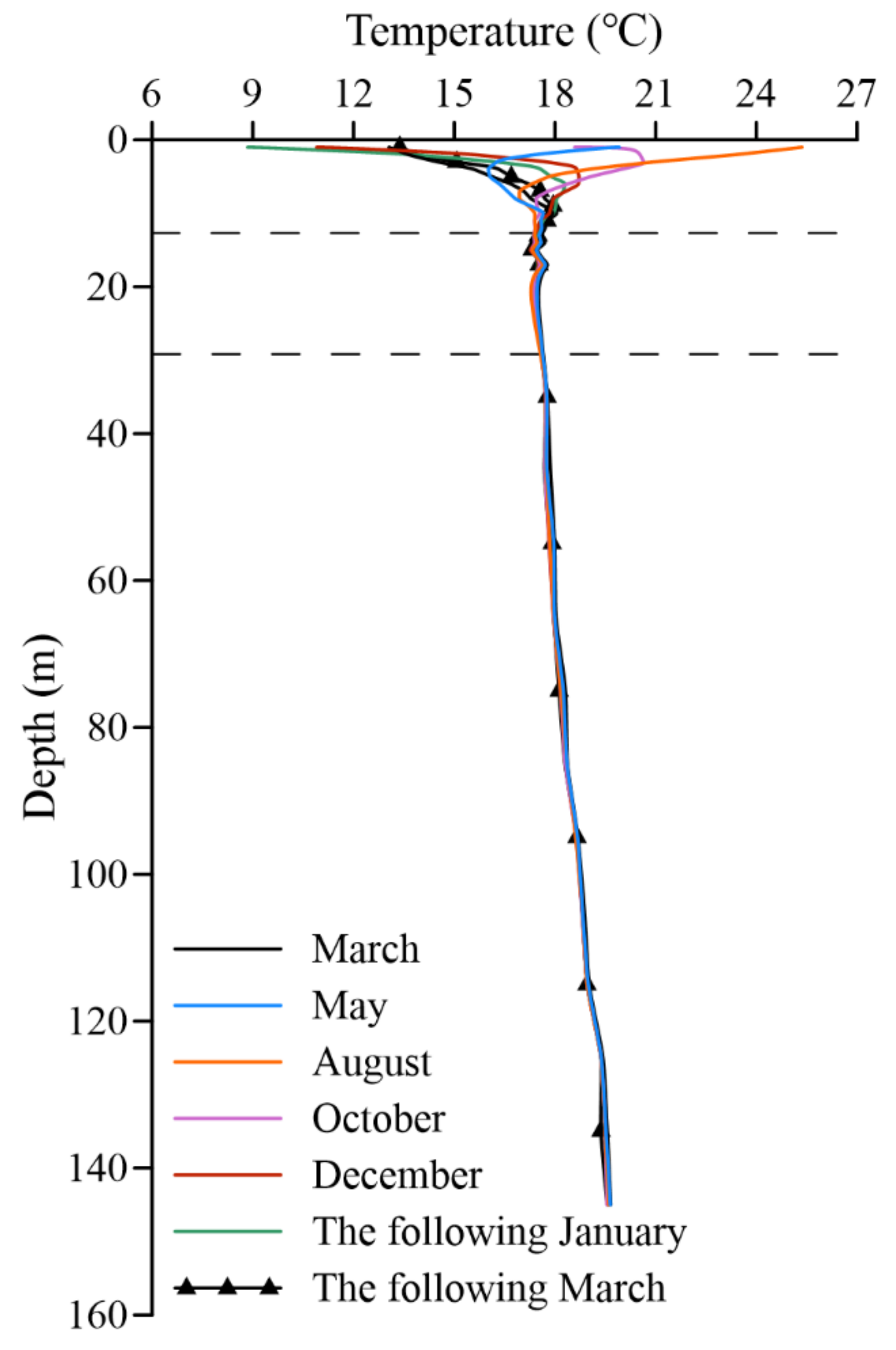
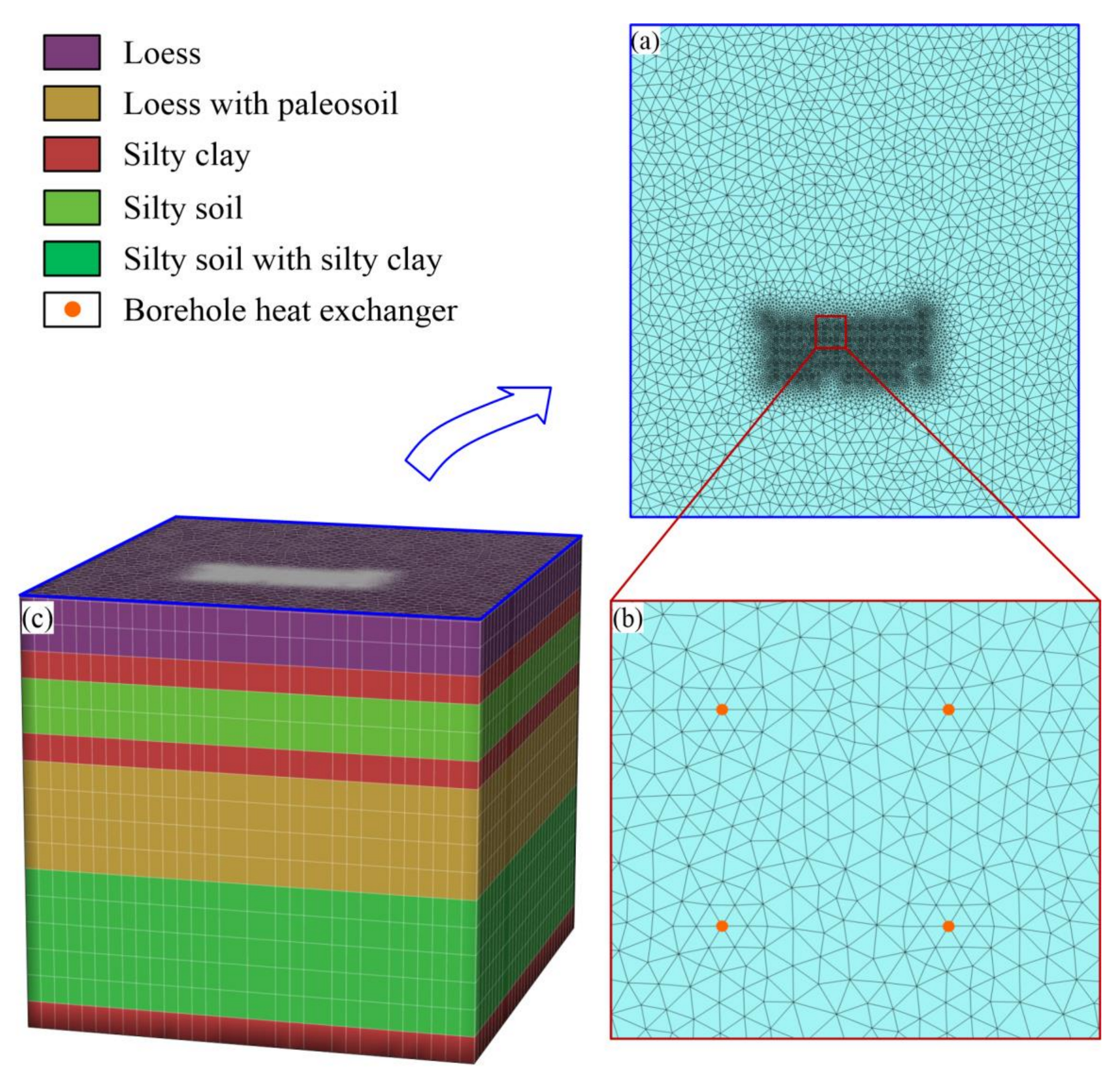
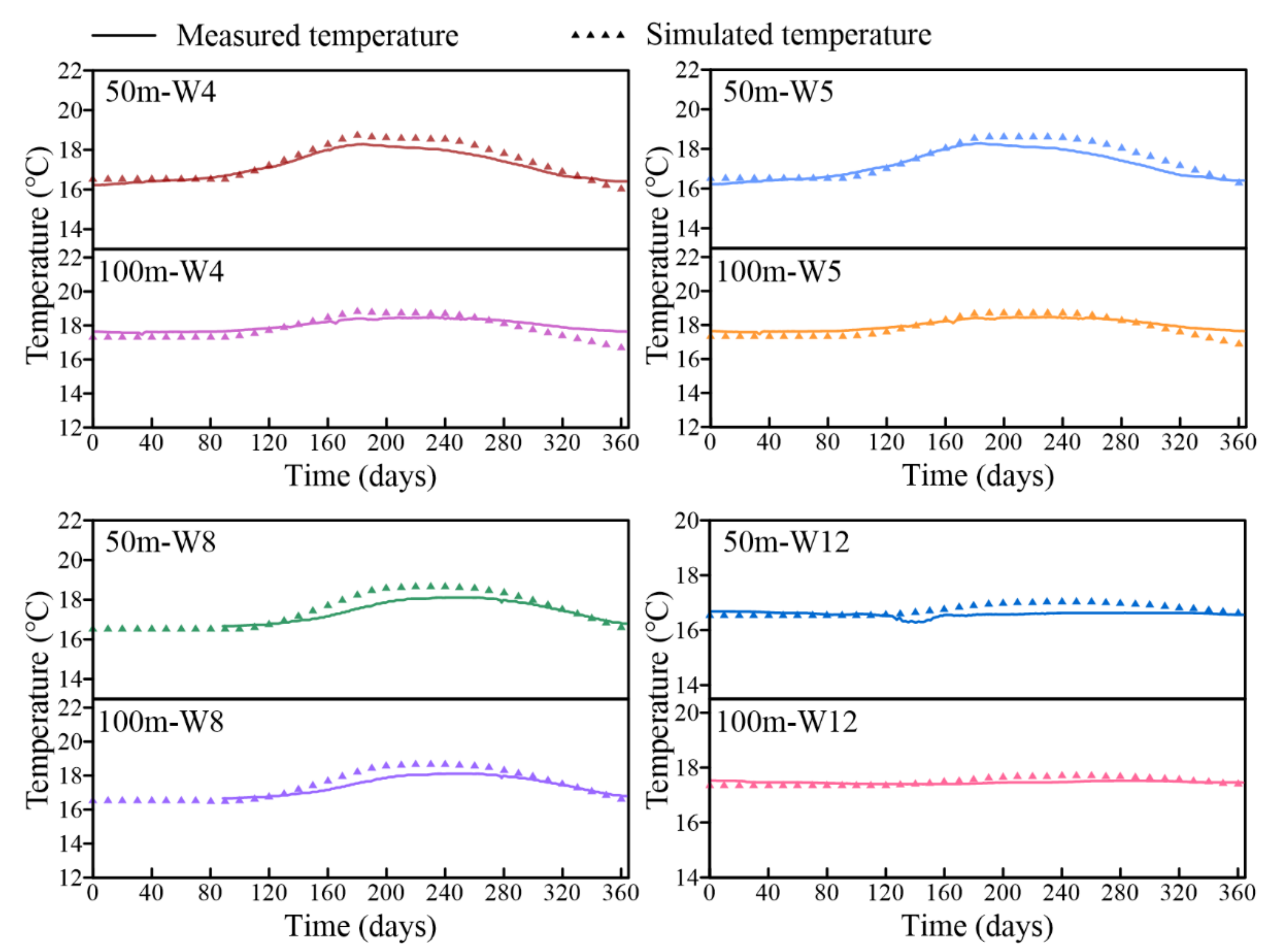
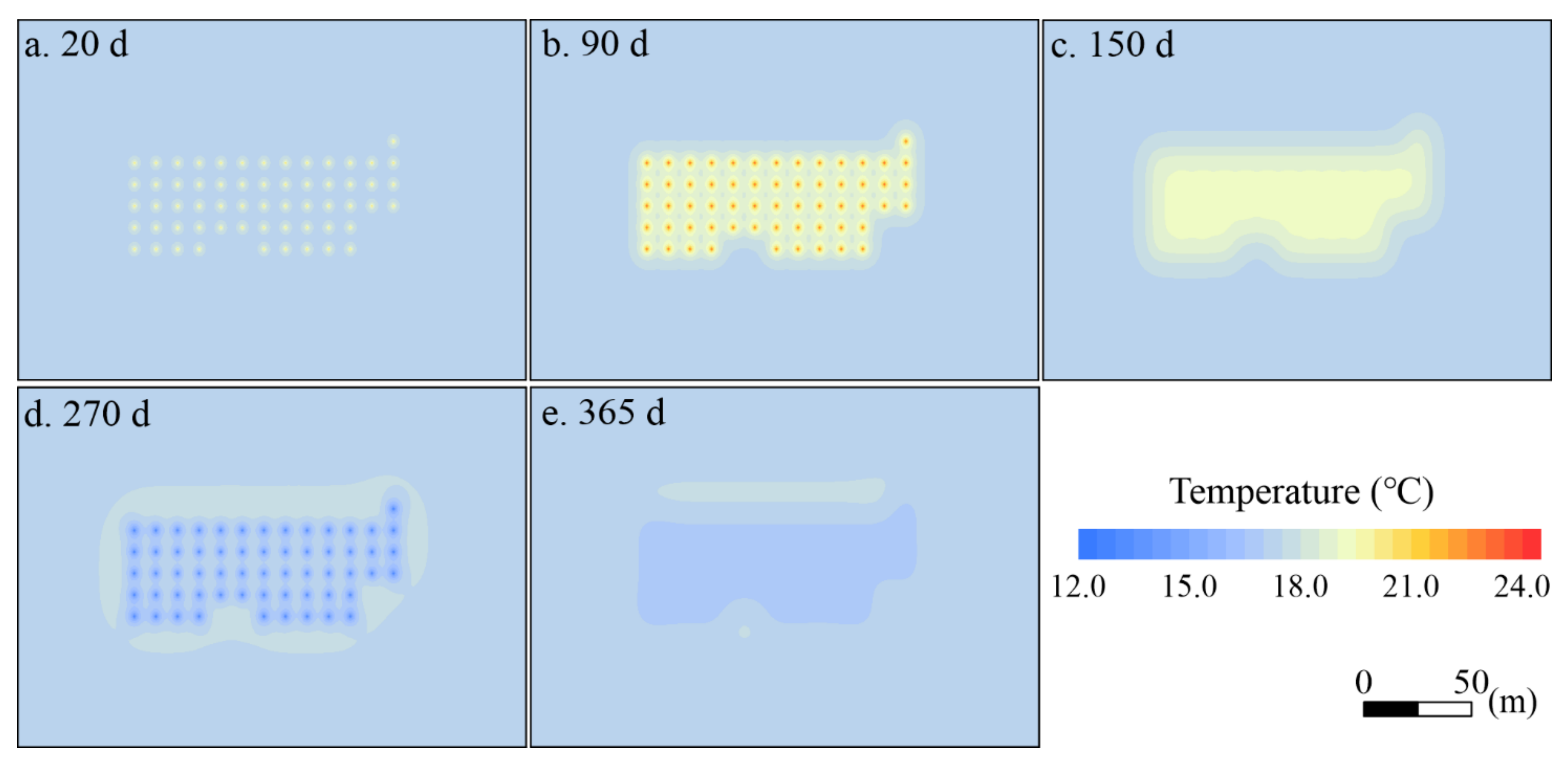
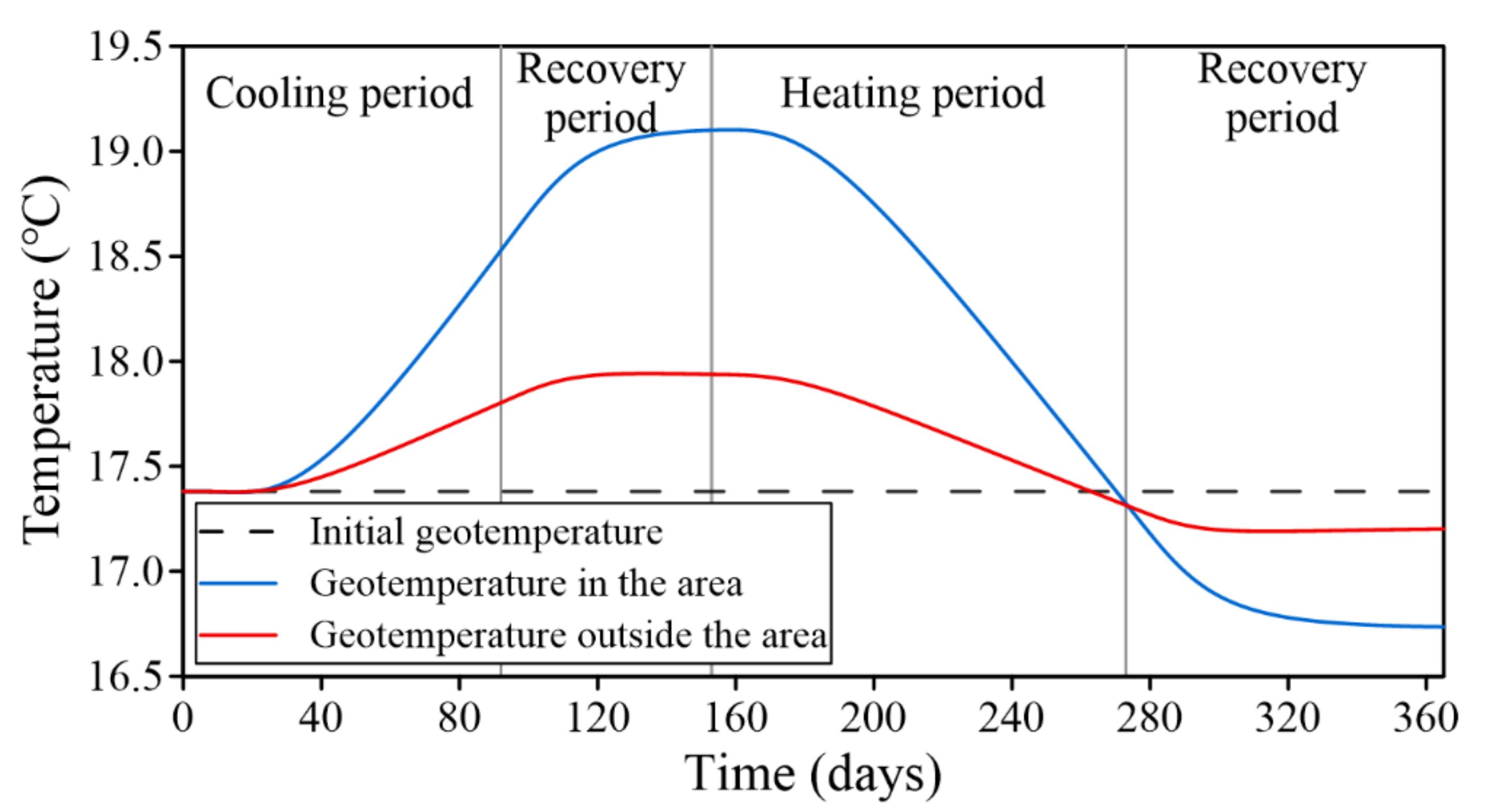

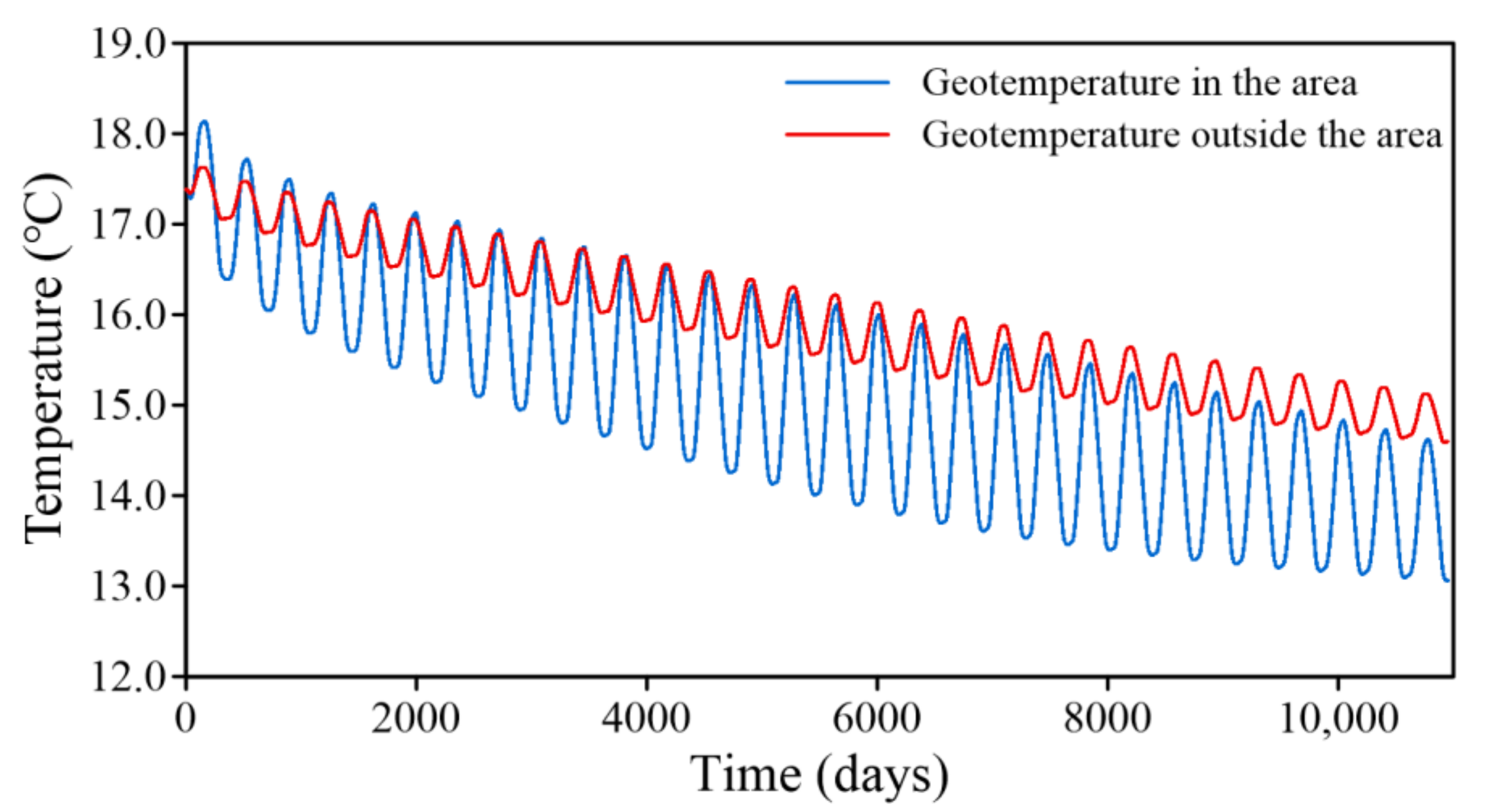
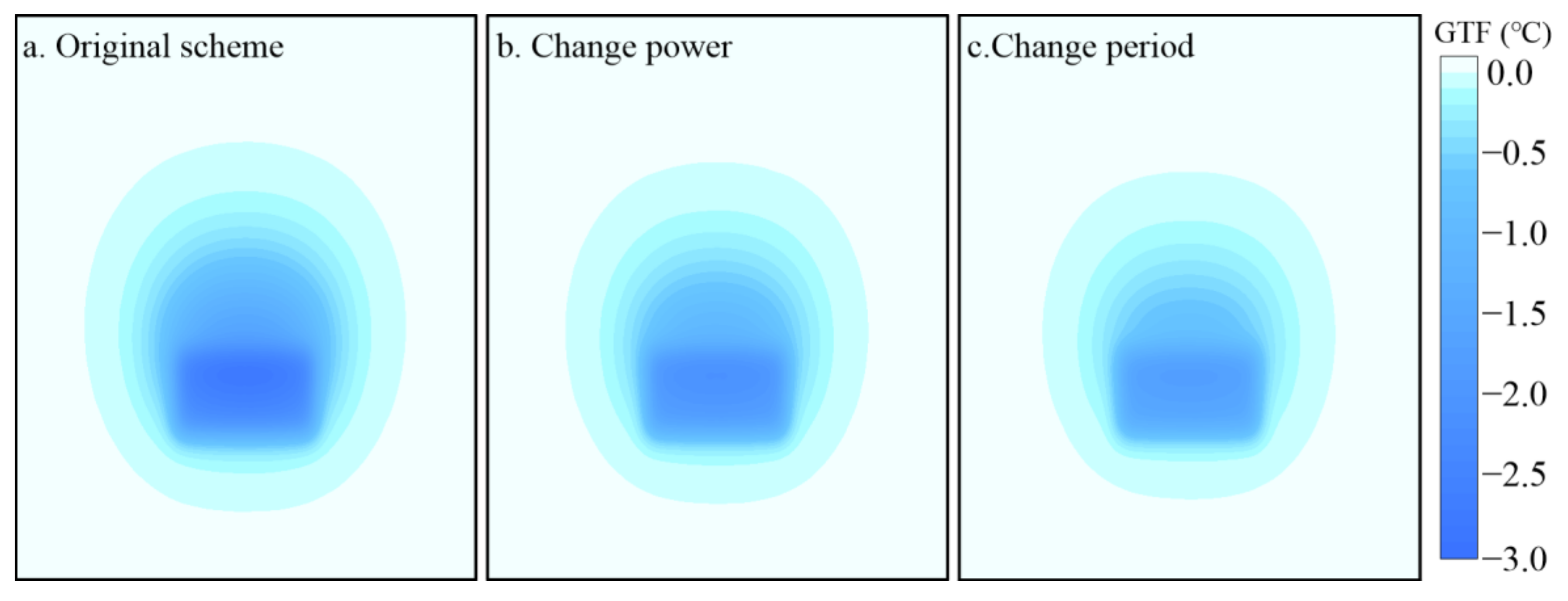
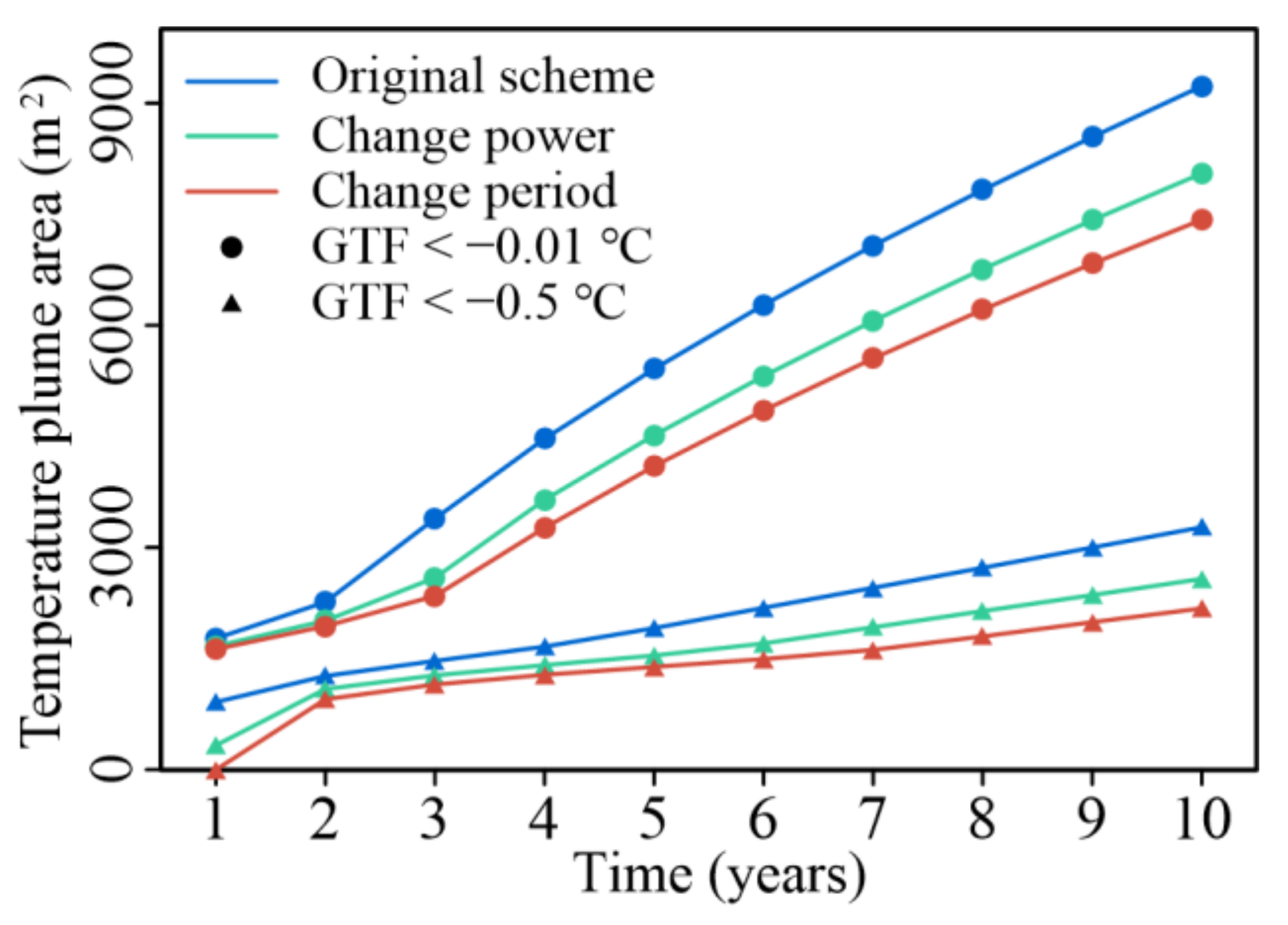

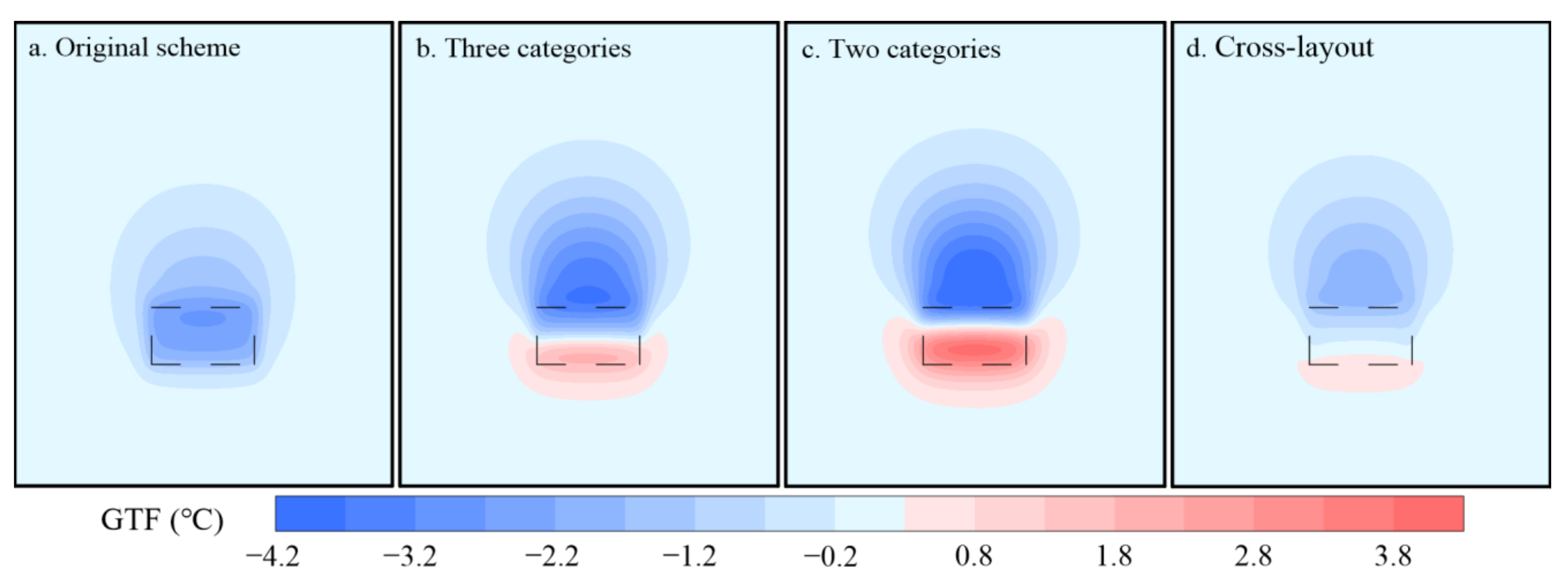
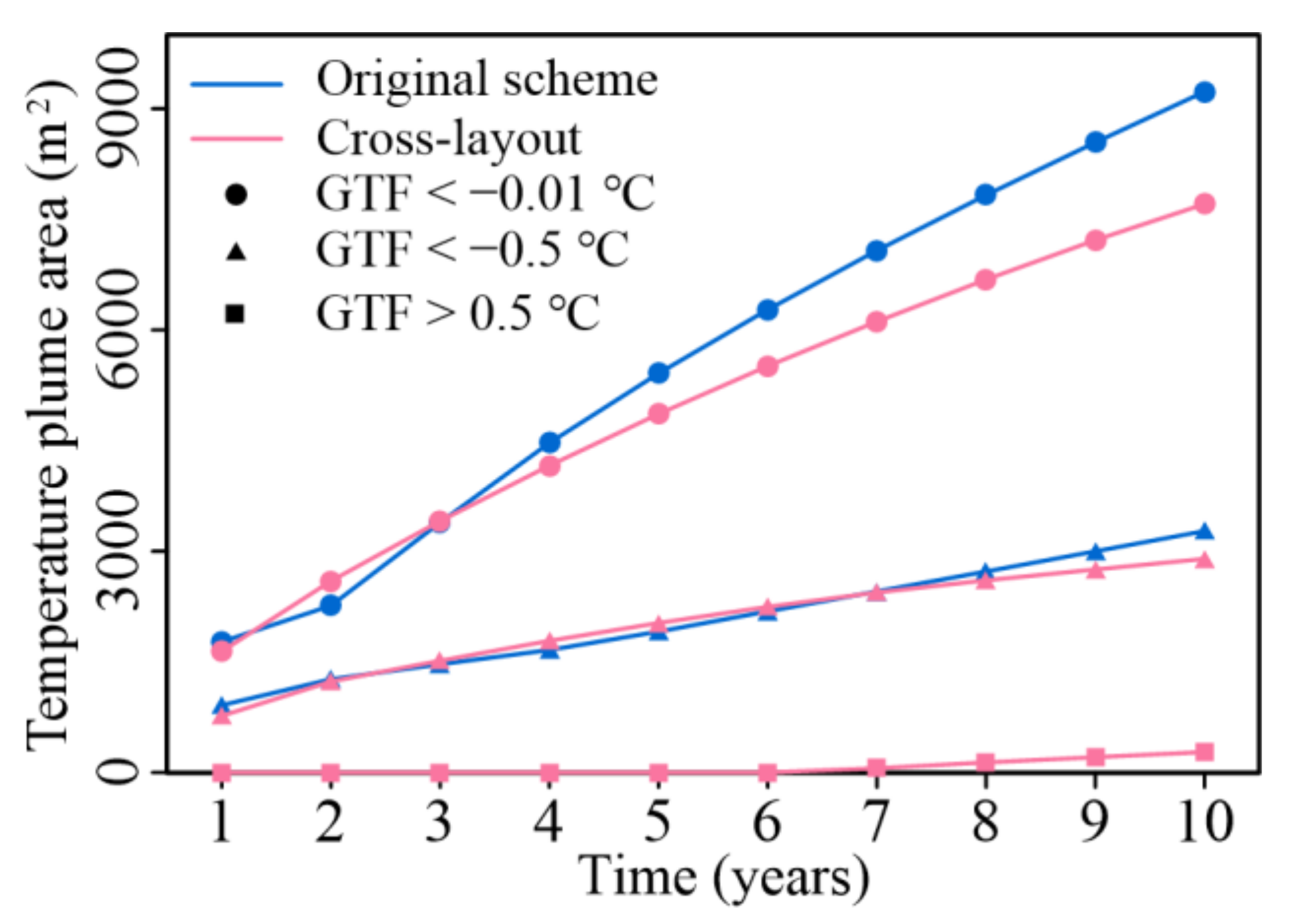

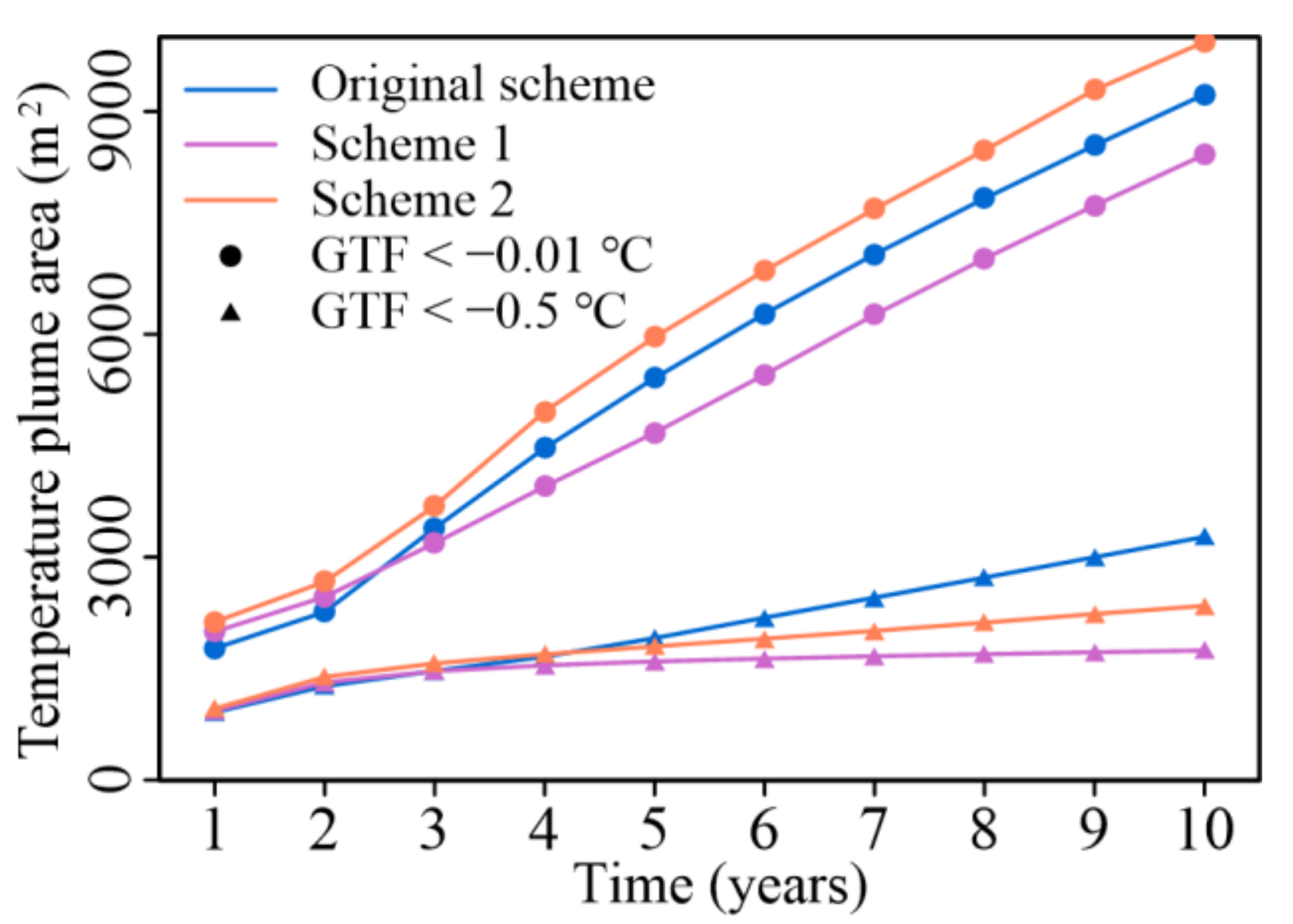
| Soil Sample Type | Sample Size | Soil Water Content | Dry Unit Weight | Thermal Conductivity | Specific Heat Capacity |
|---|---|---|---|---|---|
| (%) | (kN/m3) | (W/m·K) | (kJ/kg·K) | ||
| Loess | 11 | ||||
| Silty clay | 10 | ||||
| Silty soil | 8 | ||||
| Paleosoil | 2 | ||||
| Coarse sand | 1 |
| Lithology | Hydraulic Conductivity (m/d) | Porosity | Volumetric Heat Capacity MJ/(m3·K) | Thermal Conductivity W/(m·K) | |
|---|---|---|---|---|---|
| Horizontal | Vertical | ||||
| Loess | 0.20 | 0.25 | 0.37 | 2.44 | 1.70 |
| Loess with paleosoil | 0.15 | 0.20 | 0.38 | 2.90 | 1.65 |
| Silty clay | 0.05 | 0.005 | 0.39 | 2.98 | 1.67 |
| Silty soil | 0.50 | 0.05 | 0.36 | 2.90 | 1.64 |
| Silty soil with silty clay | 0.10 | 0.01 | 0.37 | 2.85 | 1.65 |
| Parameters | Value |
|---|---|
| Load | Summer, 4968 kW·h; winter, 5558.4 kW·h |
| Flow rate | 120 m3/d |
| Borehole depth | 150 m |
| Diameter | 0.15 m |
| Backfill materials’ thermal conductivity | 1 W/(m·K) |
| Circulating fluid’s thermal conductivity | 0.48 W/(m·K) |
Disclaimer/Publisher’s Note: The statements, opinions and data contained in all publications are solely those of the individual author(s) and contributor(s) and not of MDPI and/or the editor(s). MDPI and/or the editor(s) disclaim responsibility for any injury to people or property resulting from any ideas, methods, instructions or products referred to in the content. |
© 2023 by the authors. Licensee MDPI, Basel, Switzerland. This article is an open access article distributed under the terms and conditions of the Creative Commons Attribution (CC BY) license (https://creativecommons.org/licenses/by/4.0/).
Share and Cite
Li, Y.; Liu, P.; Wang, W.; Ke, X.; Jiao, Y.; Liu, Y.; Liang, H. Optimizing the Layout of a Ground Source Heat Pump System with a Groundwater–Thermal Coupling Model. Energies 2023, 16, 6895. https://doi.org/10.3390/en16196895
Li Y, Liu P, Wang W, Ke X, Jiao Y, Liu Y, Liang H. Optimizing the Layout of a Ground Source Heat Pump System with a Groundwater–Thermal Coupling Model. Energies. 2023; 16(19):6895. https://doi.org/10.3390/en16196895
Chicago/Turabian StyleLi, Yujiao, Peng Liu, Wei Wang, Xianmin Ke, Yiwen Jiao, Yitian Liu, and Haotian Liang. 2023. "Optimizing the Layout of a Ground Source Heat Pump System with a Groundwater–Thermal Coupling Model" Energies 16, no. 19: 6895. https://doi.org/10.3390/en16196895
APA StyleLi, Y., Liu, P., Wang, W., Ke, X., Jiao, Y., Liu, Y., & Liang, H. (2023). Optimizing the Layout of a Ground Source Heat Pump System with a Groundwater–Thermal Coupling Model. Energies, 16(19), 6895. https://doi.org/10.3390/en16196895






